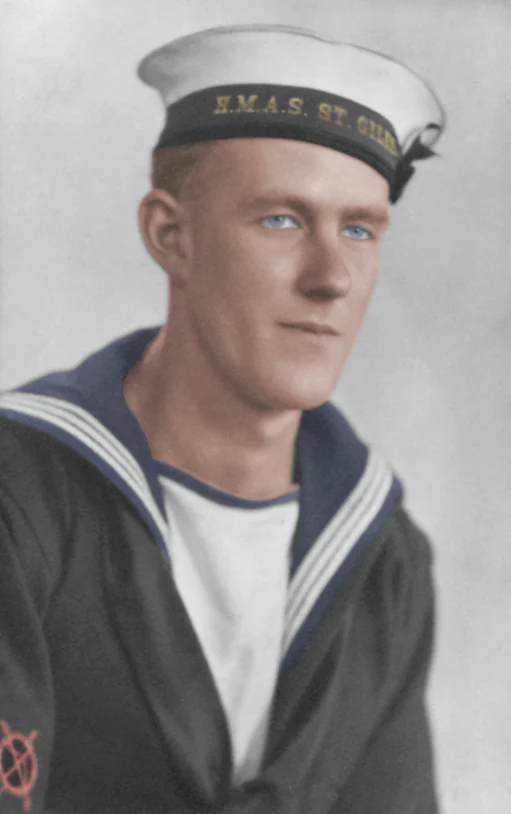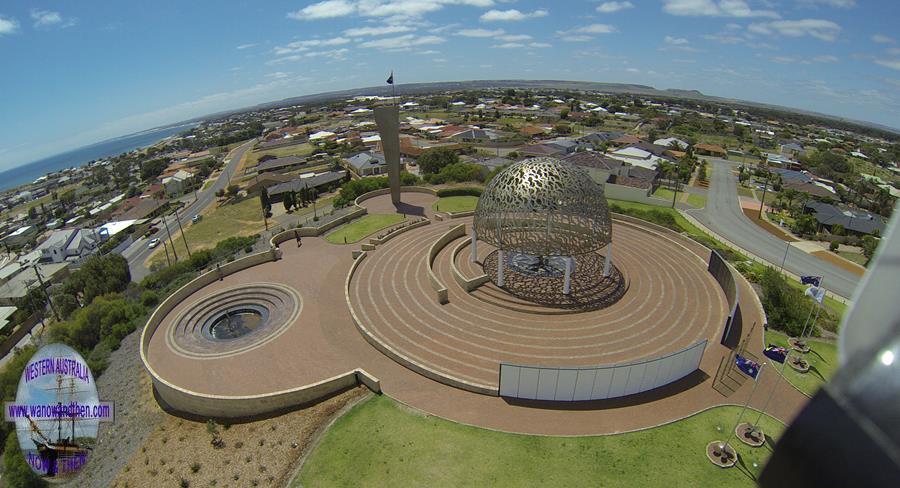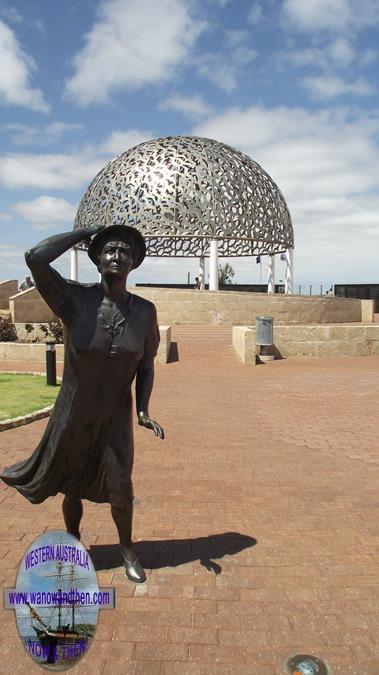|
The first ship to bear the name HMAS Sydney was a Town class light cruiser in World War One.
It became the first R.A.N. ship to engage the enemy and destroyed the German light cruiser Emden off the Cocos Islands on the 9th of November 1914.
The second ship to bear this name in the Royal Australian Navy was a
Perth class light cruiser. She already had battle honours from engaging and sinking the Italian light cruiser Bartolomeo Colleoni and badly damaging a second light cruiser in the
same action.
On November 11th 1941 the Sydney left Fremantle on a routine escort mission. She was due back in port on November 20th. When nothing was heard
from the cruiser by November 23rd a search was organised and when German sailors were rescued in the Shark Bay area it was discovered that the Sydney had been involved
in a fight with the German raiding ship Kormoran.
COMPARING THE SHIPS
|
Attribute
|
Sydney
|
Kormoran
|
|
Main armament
|
8 x 6 inch (15.24cm) guns
|
6 x 15cm guns
|
|
Maximum effective range
|
24,800 yards
|
18,100 yards
|
|
Rate of fire
|
8 rounds a minute
|
8 rounds a minute
|
|
Secondary armaments
|
4 x 4 inch AA guns
8 x 21 inch torpedoes
5 x 300 lb depth charges
|
5 x 2cm AA guns
2 x 3.7cm anti tank guns
MG 34 machine guns
6 torpedo tubes 50 cm torpedoes
Mines
|
|
Maximum speed
|
31.5 knots
|
18 knots
|
|
Other
|
Walrus amphibious aeroplane
|
2 Arado float planes with bombs and torpedoes
|
|
Type of ship
|
Warship (armoured)
|
Converted freighter (unarmoured)
|
A simple comparison of the two ships main armament and the maximum speeds clearly shows that the Sydney was far superior to the Kormoran. The Kormoran could not
out-run Sydney and the Sydney could easily have sat out of range of the Kormoran's guns and attacked with her own main armament.
Sydney could bring all her 8 main guns to bear at the same time whereas Kormoran could only engage with a maximum of 4 guns from her main armament of 6.
The question that will probably never be answered is, why did Captain Joseph Burnett take his ship to less than 2000 yards of the Kormoran when the identity of the freighter
was in doubt and she had already acted suspiciously?
Whatever the reason was, it put his ship in grave danger and the crew paid for it with their lives.
None of the 645 crew aboard Sydney survived although over 300 Germans were rescued from lifeboats or landed on the coast north of Carnarvon.
The reason for this discrepancy was shrouded in mystery until the ships were finally located in 2008.
What really happened ? These are the facts as we know them today.....
HMAS Sydney having successfully escorted her charge to a point near Christmas Island, handed over to a British ship and turned back for
Fremantle. Late in the afternoon of November 19th 1941 the Sydney spotted an unidentified freighter and immediately gave chase. The freighter changed course away
from the safety of the W.A. coast and increased speed - something that would have alerted Captain Burnett to possible danger - and Sydney sent signals requesting
that the freighter identify itself and telling it to stop.
Eventually Sydney received a reply that the freighter was the Dutch ship, Straat Malacca, but no proper identification code was given. For whatever reason Captain
Burnett now decided to close on the freighter instead of launching his seaplane to investigate further.
When pressed to give their secret identity code the German ship dropped its camouflage and immediately began firing at Sydney at a range estimated of around 1600 yards.
Reports from German crew members are that Sydney's bridge was hit with the first or second salvo and after a short time the front gun turrets on Sydney were out of action.
The seaplane was destroyed and much of Sydney's superstructure was hit. She quickly became engulfed in fire. The lack of radio contact (1) from the Sydney after she
was engaged, supports the reports that the superstructure and forward mast (with radio ariels) had been badly damaged. Sydney was also hit by a torpedo from Kormoran
at about this time.
Sydney now turned to port (left) and crossed the stern of the Kormoran. Whether the turn was deliberate, or whether it was caused by damage we can never know, but it
now brought Sydney's starboard side into the sights of the German guns.
As she passed astern, Sydney fired 4 torpedos at Kormoran and soon afterwards the rear turrets engaged the raider. Kormoran was fatally damaged and the engagement broke
off after about 55 minutes, with Sydney sailing away at about 7 knots to the south east and burning fiercely. Kormoran was soon abandoned and it was around 11 pm that a
glow on the horizon from the fires on Sydney was last seen.
One of the most perplexing things about the loss of the Sydney was the lack of floating wreckage or a large oil slick. This can be partially explained by the fires on board consuming
much of the loose equipment on deck and the fact that it was not until 5 days after the engagement that any search was started.
The Sydney seems to have been needlessly put in harm's way with the resulting tragic loss of whole ship's crew. Over the years all sorts of excuses have been given for Captain Burnett's
actions but the fact remains that he could easily have stayed out of range of the German guns and identified the ship as a raider from a safe distance. The question then has to be raised,
was Captain Burnett negligent or is it possible then that he was lured in too close when the German skipper raised a white flag or signalled his intention to surrender and then opened fire
when Sydney was too close to miss?
If this was what happened then the loss of the Sydney would have to be regarded as a war crime. Sydney was still apparently under power as she left the scene of the battle so why
did none of her crew survive?
When later questioned about the issue of raising the German flag before commencing firing, those men who shared a lifeboat with the German captain were all most adamant that the
flag was raised before firing commenced. This seems to indicate, at the very least, some pre-planning of a story to tell once they were taken prisoner as it became evident from
interviewing the men in this life boat that not all of them would have been in a position to know if the German flag had been raised or not.
Some members of the German crew reported seeing the Sydney's port cutter being readied and lowered as she closed with the Kormoran. This gives further weight to the theory
that the Kormoran had indicated that it was surrendering and that Burnett was preparing to board her.
The only members of the Sydney's crew not to be killed were two stokers who were absent without leave before the ship sailed. Luckily for them they were in lock-up when the ship
left Fremantle.
On February 6th 1942 a raft containing the body of a dead seaman washed up on the shore of Christmas Island. It has been said that this body came from
the Sydney but as no investigation could be carried out at the time this took many years to confirm. In October 2006 the remains were exhumed and a metal object was found inside the skull.
This has been variously reported as a 9mm bullet or a piece of shrapnel.
DNA testing was done on the remains to try and identify who the sailor was and finally in November 2021, the identity of the sailor was uncovered.
The only sailor known to have made it off HMAS Sydney when she sank was Able Seaman Thomas Welsby Clark.


HMAS Sydney found and some questions may be partially answered.
The remains of the HSK Kormoran were found by the Finding Sydney Foundation on 12th March 2008 at 26 05 49.4 S 111 04 27.5 E, at a depth of approximately 2,560 metres.
The remains of the HMAS Sydney II were found by the same group on 17th March 2008 at 26 14 37 S 111 13 03 E, approximately 207km (128 miles) from Steep Point
on the west coast of Western Australia at a depth of around 2,468 metres.
Once the Sydney was located it quickly became apparent that she had gone to the bottom with several of her lifeboats mostly undamaged and still attached to their stations.
The most surprising find was the bow section of the Sydney located near to but detached from the main part of the ship.
One possible theory is that the Sydney had been under way and heading for the coast when the bow section, already weakened by the strike from a torpedo broke off in a heavy swell.
At this point the Sydney and her crew would have had no chance of survival. The ship would have flooded in minutes with no chance to launch the life boats.
While this may answer the question of why none of the crew survived, it does not answer the question of why Sydney came so close to the German ship. Was Sydney's captain
negligent? Did the Germans open fire under a flag of surrender? These are questions that can never be answered.

A personal perspective.
Leslie Michael Blom Jr. (Les) is the son of HMAS Sydney crew member Leslie Michael Blom Sr., a stoker aboard the ship when she was engaged in the battle with the Kormoran.
Les was born soon after the sinking of the Sydney and so he never had the opportunity to meet his father.
He remembers talking to his mother about his father and was told that when his mum expressed her concern about her husband's safety, Les Sr. had always said 'Don't worry,
if anything ever happens to the ship I'll get home somehow, even if I have to swim.'
From the material he has gathered about the Sydney, Les Jr. believes that the body of the sailor who washed up on Christmas Island was dressed in the overalls of someone
from a ship's engine room. Les has always wondered if this might just have been his father who was attempting to fulfil his promise to his wife and trying to make it home any way he could.
With the advent of DNA testing, we believe that some tests were carried out on the remains from Christmas Island but Les was never asked to submit a DNA sample. As the tests
done to date have never been able to show who the sailor was, we feel it would be appropriate for more testing to be done if the DNA samples available are still viable. (2)
Les' mother waited the rest of her life for her husband to return, she never re-married and in the years soon after the sinking, if she saw a sailor in uniform who from behind reminded
her of her husband, she would go up and tap him on the shoulder in the hope that it was her husband back from the war. She died at the age of 73, still waiting for her husband to
come home.
Les' mother worked for the Lord Mayor of Fremantle (Sir Lionel Sampson) and with the other wives and girlfriends of the sailors on board the Sydney, she would walk the short
distance down to a spot near the docks at Fremantle and look out to sea, waiting for the ship to come back into port. This was the inspiration behind the bronze statue that was
erected at the Geraldton HMAS Sydney memorial, but the statue would have been much better placed in Fremantle where the wives would wait for their loved ones to come home.
Were there witnesses?
Joe and Ivy Mallard operated Carrarang Station during the Second World War and Ivy made a statement in 1992 about events that took place one evening while she and her
husband were relaxing on the verandah. Ivy wrote:
'Joe and I were sitting on the verandah late afternoon about dinnertime when we heard strange loud noises which were coming from the north west, away over the coast and
across Dirk Hartog Island. There was a lot of heavy boom booming going on, maybe for ten or fifteen minutes with flashes and flares plainly visible. There was an enormous
amount of grey smoke and some was black. Suddenly there was a huge explosion and burst of heavy black smoke going up in all directions, similar to atom bombs, with
flashes and bangs. It quietened down suddenly. We were both terrified as we watched it all and Joe said there must be a battle going on out there...'
(1) Some sources suggest that there was in fact a distress signal picked up but that the source may not have been correctly identified or that the report was not acted upon..
(2) Latest information on the mystery sailor. The unidentified sailor's DNA has been sequenced and current attempts to identify him centre around 50 of the ship's crew.
The sailor had unique dental work and from the investigations to date he was believed to be tall, 168-187cm, to have size 11 feet, to be right handed and aged between 22 and
31. He was of European ancestry, had red hair, blue eyes and pale skin. His dental work included 9 gold fillings and two missing teeth. He is thought to have come from NSW or
Queensland and to have eaten a diet high in seafood as a child. If any more information becomes available we will add it here.
Related Pages
World War 1 and 2 | Australian Defence Force
|








